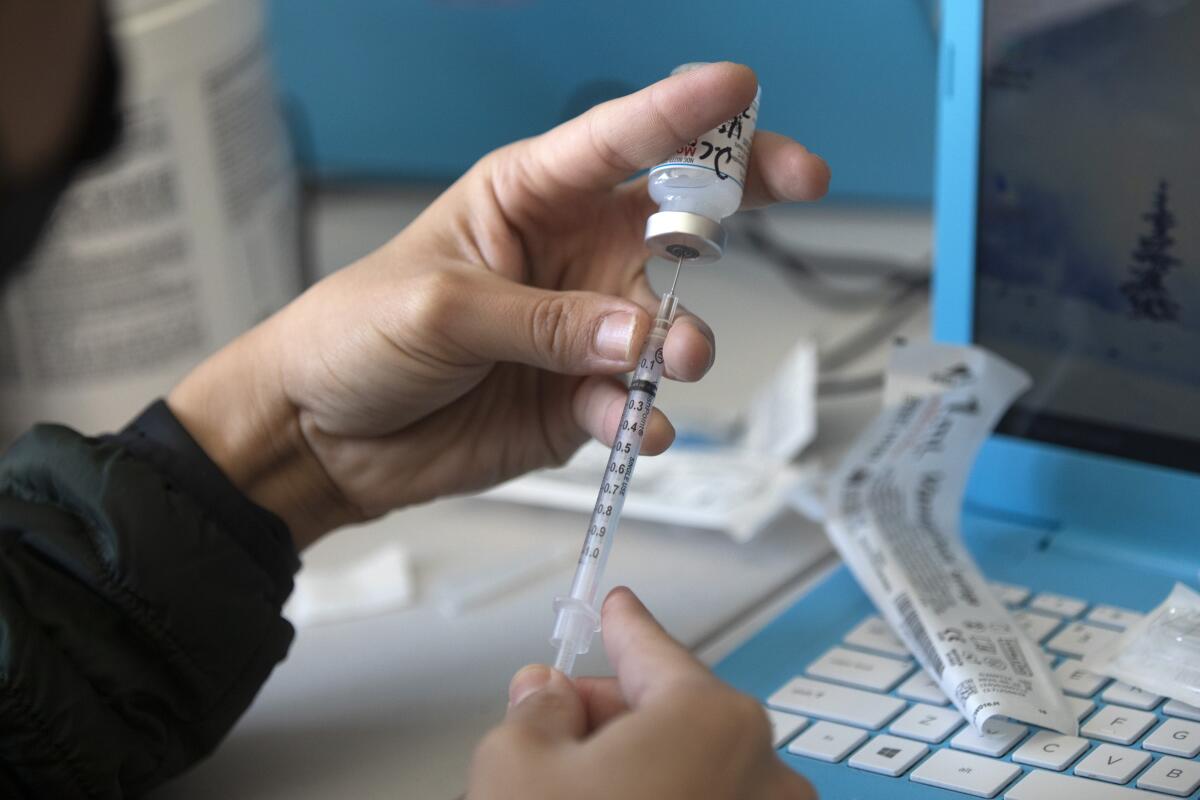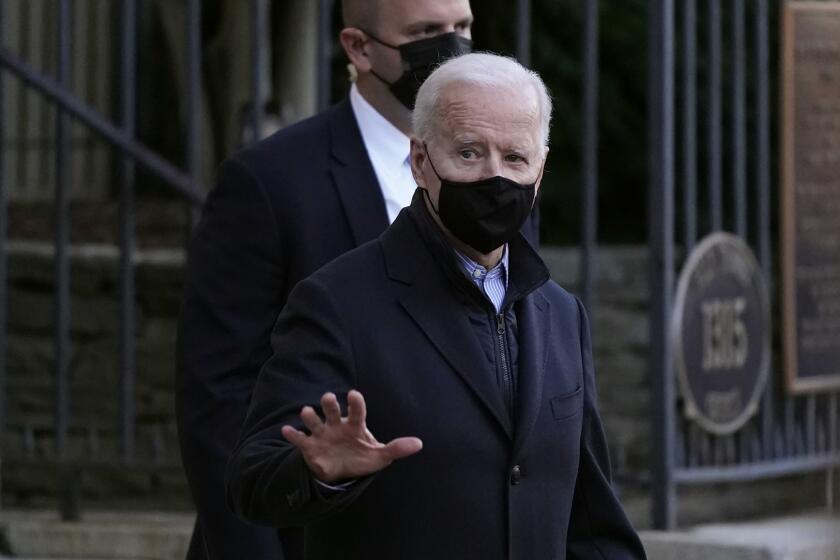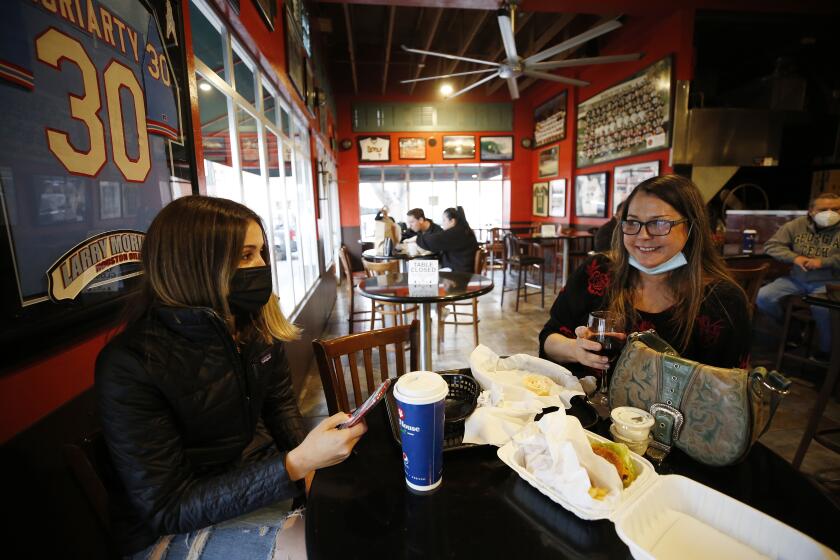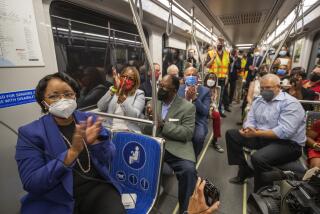What you can and can’t do after getting fully vaccinated against COVID-19

- Share via
People who have been fully vaccinated against COVID-19 can resume some parts of their old life but must remain vigilant in many ways as the pandemic continues, according to new federal guidance from the Centers for Disease Control and Prevention.
“We’ve been through a lot this past year, and with more and more people getting vaccinated, each day we are starting to turn a corner,” Dr. Rochelle Walensky, the CDC’s director, said during a briefing Monday. “And as more Americans are vaccinated, a growing body of evidence now tells us that there are some activities that fully vaccinated people can resume at low risk to themselves.”
With new rules for vaccinated Americans and a relief plan pending congressional approval, President Biden has reached a turning point in the pandemic.
Who is fully vaccinated?
Someone is considered fully vaccinated two weeks after receiving the final required shot, Walensky said. Both the Pfizer-BioNTech and Moderna vaccines entail two doses, administered weeks apart, while the newly arriving Johnson & Johnson vaccine needs only a single shot.
Walensky emphasized that the recommendations unveiled Monday “are just a first step,” and will be updated “as more people get vaccinated and the science and evidence expands, and as the disease dynamics of this country change.”
What can I do if I’m fully vaccinated?
The CDC offers the following recommendations:
- You can gather indoors with fully vaccinated people without wearing a mask.
- You can gather indoors with unvaccinated people from one other household (for example, visiting with relatives who all live together) without masks, unless any of those people or anyone they live with has an increased risk for severe illness from COVID-19.
- If you’ve been around someone who has COVID-19, you do not need to stay away from others or get tested unless you have symptoms.
- However, if you live in a group setting (like a correctional or detention facility or group home) and are around someone who has COVID-19, you should still stay away from others for 14 days and get tested, even if you don’t have symptoms.
- You should still take steps to protect yourself and others in many situations, like wearing a mask, staying at least six feet apart from others, and avoiding crowds and poorly ventilated spaces. Take these precautions whenever you are:
- In public
- Gathering with unvaccinated people from more than one other household
- Visiting with an unvaccinated person who is at increased risk of severe illness or death from COVID-19 or who lives with a person at increased risk
- You should still avoid medium- or large-sized gatherings.
- You should still delay domestic and international travel. If you do travel, you’ll still need to follow CDC requirements and recommendations.
- You should still watch out for symptoms of COVID-19, especially if you’ve been around someone who is sick. If you have symptoms of COVID-19, you should get tested and stay home and away from others.
- You will still need to follow guidance at your workplace.
The new guidance underscores what health officials and experts have been saying for weeks — that the vaccine can bring some lifestyle changes but not a full-blown return to pre-pandemic life.
Here are some other key points experts are making:
Dinner parties
It would be safest to wait until everyone getting together is vaccinated, health experts say. Full protection may not come until a week or two after the required number of vaccine doses.
Gatherings
Dr. Monica Gandhi, a UC San Francisco professor of medicine and medical director of the HIV Clinic at Zuckerberg San Francisco General Hospital, said at a campus forum that she thinks fully vaccinated people can be free to mingle with one another, such as at a party, without restrictions.
But when vaccinated people are around those who haven’t gotten their inoculations, everyone should keep their masks on, Gandhi said. “Let’s keep it safe and keep our masks on around the unvaccinated,” she said.
Though some outside the federal government have expressed opinions about what is considered safe, Andy Slavitt, a senior advisor to the White House COVID-19 response team, said at the briefing last month that while “that’s a part of the discourse ... it’s not one that we are going to jump in to too hastily.”
Federal officials underscored that point Monday.
“You can visit your grandparents if you have been vaccinated and they have been too,” Walensky said.
It’s more complicated when vaccinated people mingle with unvaccinated people, though. Walensky said those who are vaccinated can safely join small gatherings if the unvaccinated residents are at low risk for serious disease. Mitigation steps like masks or spending time outdoors remain necessary if vulnerable people are involved.
Hugs
Federal COVID-19 czar Dr. Anthony Fauci said last month that even after being fully vaccinated, people could “have the virus in your nasopharynx that you could shed. And theoretically, you could infect someone else.”
“That’s the reason why we say, until we get the answer — and we will get the answer to that question, hopefully within the next couple of months — but we tell people that even though you’re vaccinated, you should wear a mask, because you might be shedding virus that could infect others.”
Fauci did say that if both parties had been vaccinated, they could hug away.
Double masking
In guidance released Thursday by the California Department of Public Health, officials said double masking “is an effective way to improve fit and filtration.”
“A close-fitting cloth mask can be worn on top of a surgical/disposable mask to improve the seal of the mask to the face,” the advisory says. “Layering more than two masks is not recommended as this could be difficult to breathe through. Also, it is not recommended to wear two medical masks, or to wear a medical mask on top of a KN95 or an N95.”
Specifically, California officials said:
- In indoor spaces, with people from outside your household.
- In close quarters with other people where social distancing is not possible (examples: riding a crowded bus, waiting in line at a crowded airport terminal).
- In any public place for people who are older or who have medical conditions that put them at higher risk of severe COVID-19 illness.
A federal report released in February also recommended wearing two masks in some cases. The CDC found that wearing a cloth mask over a medical one can substantially reduce a wearer’s exposure to potentially infectious aerosols. Adjusting a medical mask to fit more tightly can also provide similar protection, the report said.
Recent lab tests conducted with dummies found that both the cloth-medical mask combination and the tighter-fitting medical mask decreased exposure by about 95%, the CDC said.
That should come as little surprise, given that the coronavirus spreads most commonly in the air, when someone inhales infectious droplets or other tiny respiratory particles. Experts and officials have long noted that properly fitted masks and other face coverings can help prevent person-to-person transmission.
Experts also have suggested that masks should continue to be worn and say that N95 and KN95 masks offer superior protection.
KN95 masks — built to a Chinese design — filter up to 95% of particles in the air. They may be preferable for those who must be in close contact with people who don’t live in the same household or for people who are at an increased risk for severe illness from COVID-19, according to the CDC. The CDC’s website offers tips on what to look for in purchasing a KN95 mask.
The CDC, however, points out that such masks often require more effort to breathe and may be more expensive and difficult to obtain. Poor quality is also a problem; at least 60% of the KN95s evaluated by the CDC’s National Institute for Occupational Safety and Health were found to not meet the requirements their manufacturers claimed to meet.
There are a number of things that could go wrong in California’s quest to put an end to the pandemic.
Travel
One area where the CDC is not currently updating its guidance is travel. Walensky said Americans, even those who are fully vaccinated, should continue to avoid nonessential trips.
“Every time that there’s a surge in travel, we have a surge of cases in this country,” she said. “We know that many of our variants have emerged from international places, and we know that the travel corridor is a place where people are mixing a lot.
“We are really trying to restrain travel at this current period of time, and we’re hopeful that our next set of guidance will have more science around what vaccinated people can do.”
What’s next?
Although scientists are confident that the Moderna and Pfizer-BioNTech vaccines for COVID-19 are 94% to 95% effective in preventing clinically recognizable disease, they don’t yet know whether vaccinated people can be asymptomatic carriers of the virus.
“Our guidance must balance the risk to people who have been fully vaccinated, the risks to those who have not yet received the vaccine, and the impact on the larger community transmission of COVID-19 with what we all recognize to be the overall benefits of resuming everyday activities and getting back to some of the things we love in life,” Walensky said Monday.
More to Read
Sign up for Essential California
The most important California stories and recommendations in your inbox every morning.
You may occasionally receive promotional content from the Los Angeles Times.
















